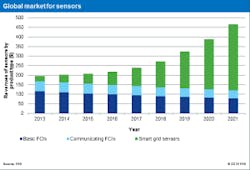North America Expected to Dominate Smart Grid Sensor Market: Study
The research firms sees the market roughly doubling in size every two years and reaching $350 million by 2021.
The sensors offer utilities granular detection of activity on the grid and can assist in fault detection, theft prevention, balancing distributed energy resources, and other functions.
Fizza Arshad, IHS market analyst, attributes the growth to smart grid funding by the U.S. government under the American Recovery and Reinvestment Act of 2009. The money allowed utilities to install extensive distribution-layer communications networks, the underpinning for use of the sensors.
“The smart grid movement that resulted from ARRA spurred interest from telecommunications providers to see critical infrastructure, like the electric grid, as a potential client base,” Arshad said.
Since last year U.S. companies have been contracting for sensors in large volumes, a thousand or more units, according to IHS. Right now there is a mixture of a few large installations and many smaller pilot projects that use the technology in the U.S.
The U.S sensor market is estimated to reach $30 million in 2014; however, annual growth from 2015 to 2021 is expected to average 36 percent.
Markets for sensors also are emerging in Europe, Latin America and other regions. In Latin America, utilities beginning pilot programs to aid fault location and theft prevention, according to IHS.
“Latin America is an untapped market with a lot of potential to grow,” Arshad said. “As the governments in this region take note of the grid problems, more and more policies and utility benchmarking schemes are being put in place to encourage investment in smart grids.”
In Europe demand for the sensors is likely to result from a need to balance distributed energy and renewables on the grid. Sales of underground sensors should be strong in Europe, since residential solar installations tend to be concentrated in dense, urban environments made up of large underground distribution networks, the research firm said.
Track news about sensors and other energy measurement tools by following us on Twitter @EfficiencyMkts.
About the Author
Elisa Wood
Editor-in-Chief
Elisa Wood is the editor and founder of EnergyChangemakers.com. She is co-founder and former editor of Microgrid Knowledge.
